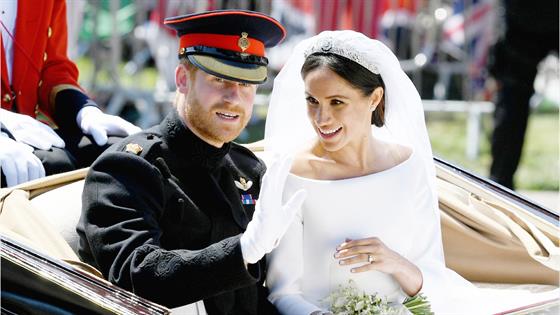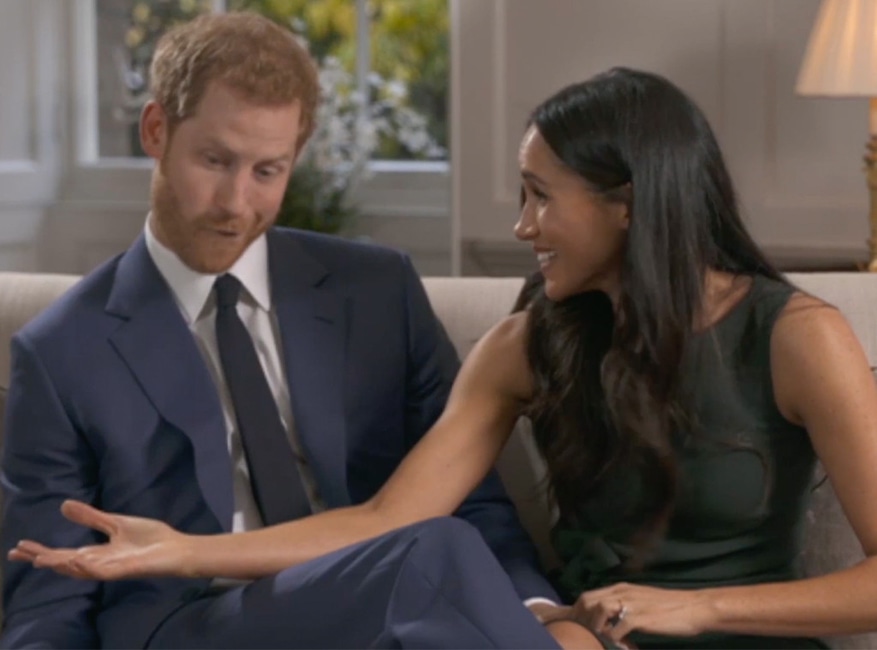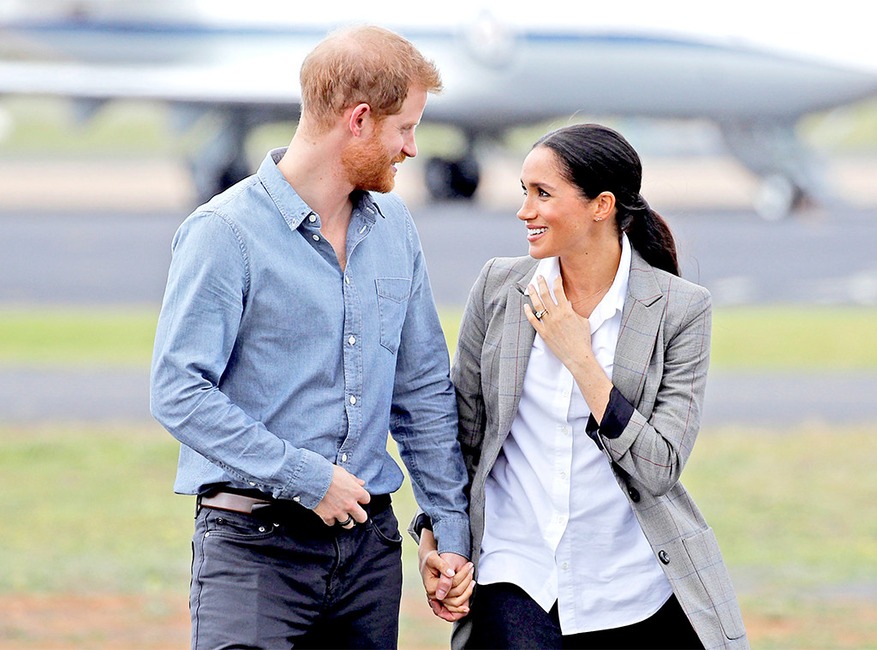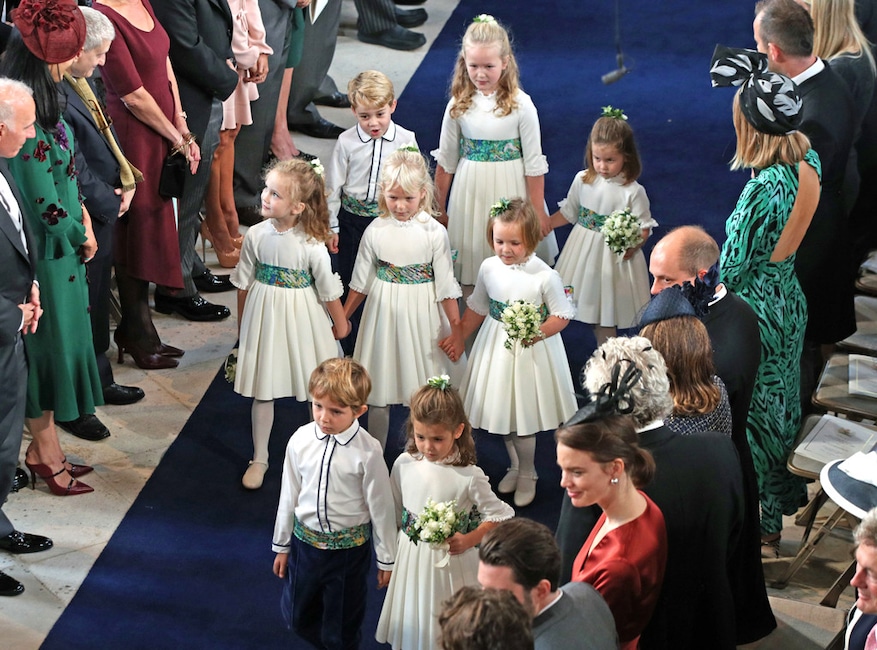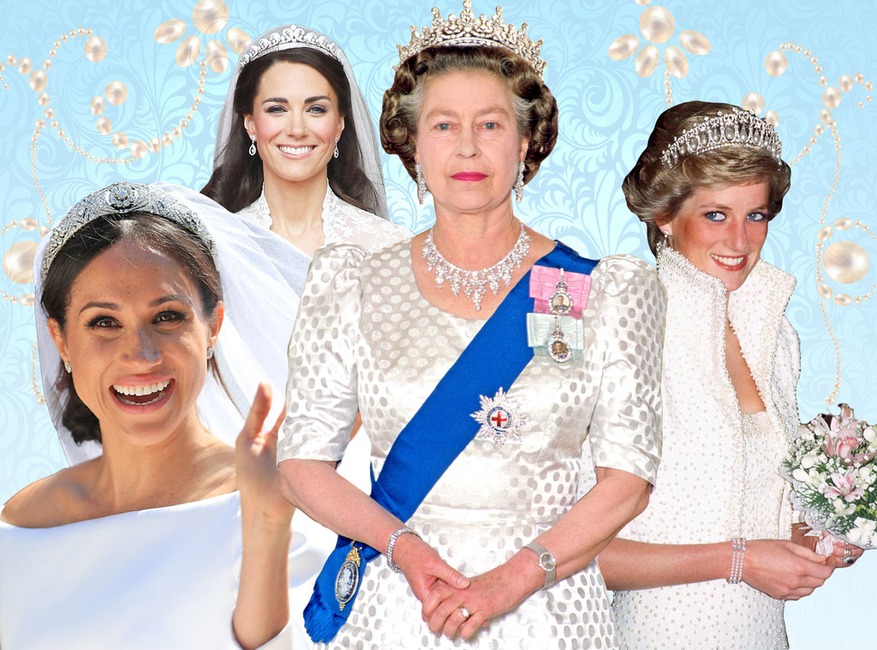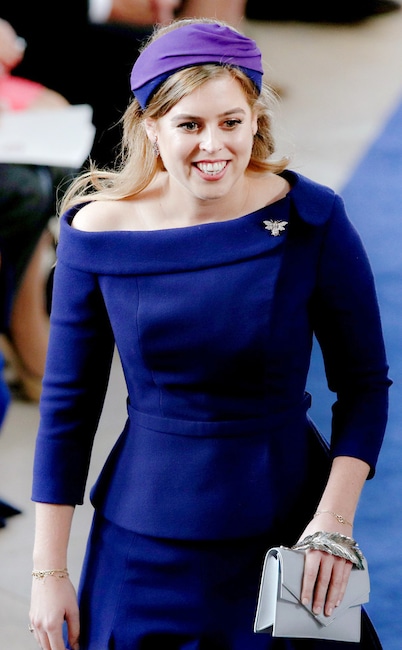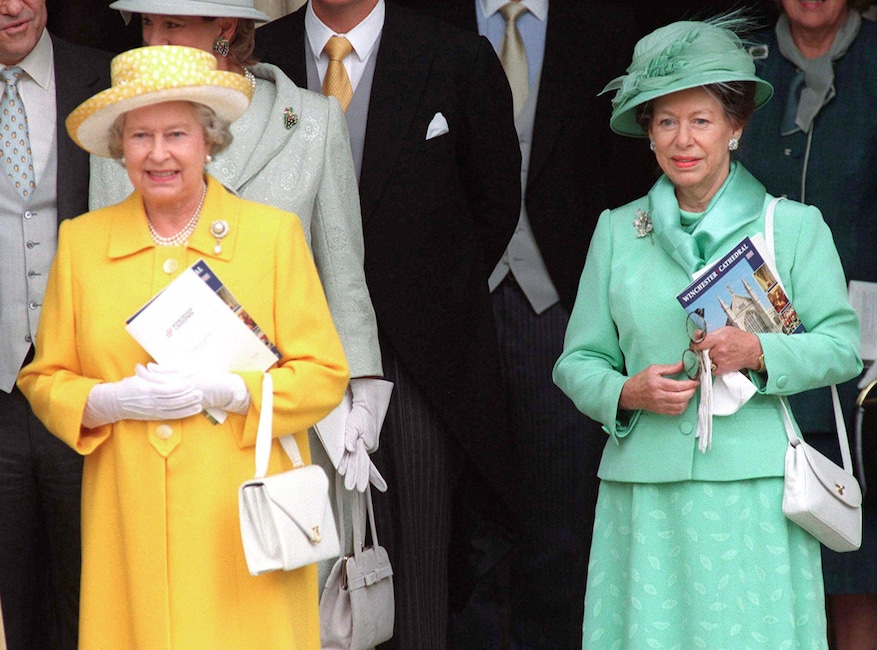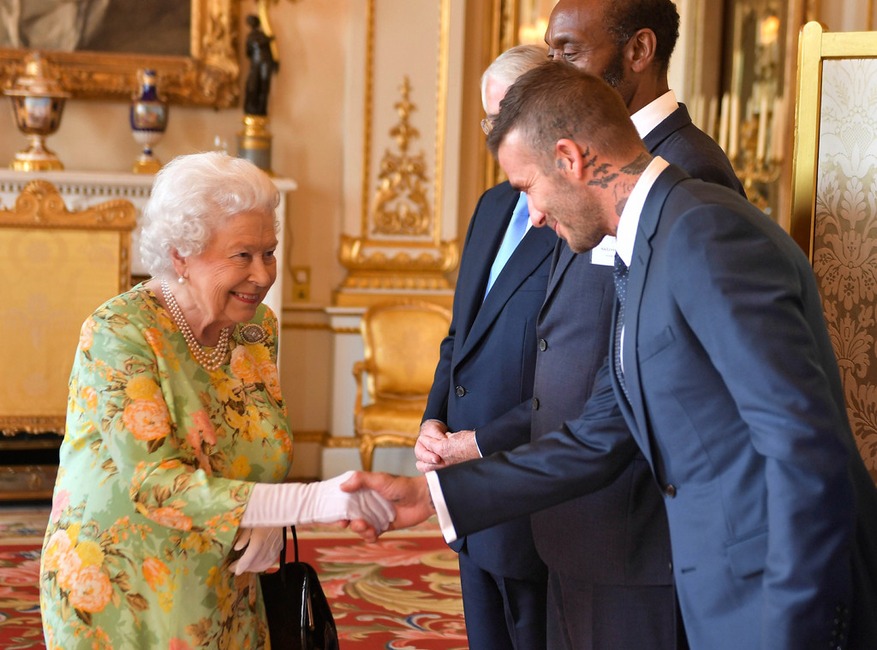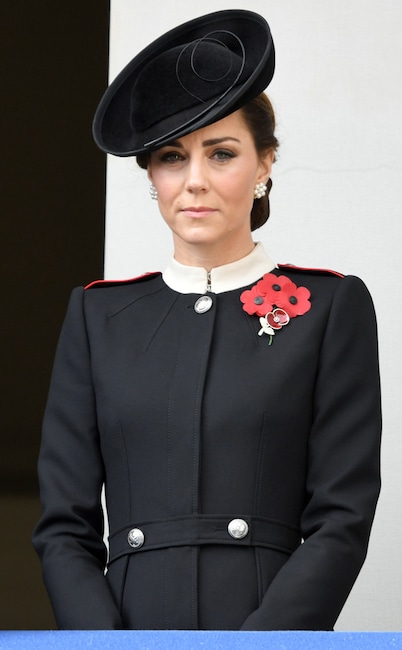The Surprising History Behind the Royal Family's Rules and Protocol

Prince Harry and Meghan Markle have always done it their way.
The new parents officially introduced their first child to the world, with the Duke and Duchess of Sussex presenting son Archie Harrison Mountbatten-Windsor on Wednesday morning.
Since they first went public with their romance in late 2016, with Harry releasing an unprecedented public statement calling out the media’s coverage of his new girlfriend and the “wave of abuse and harassment” she had been subjected to, the couple has found ways to put their own modern spin on centuries-long royal rules and traditions, earning praise and endless headlines with each bare leg photographed and selfie taken.
And their handling of Archie’s arrival and debut was no exception as even the literal handling of Archie, with Harry holding him going against the long tradition of the mother being the one to present the royal baby in their arms.
After much speculation about how and when Harry and Meghan would present Baby Sussex to the world, Buckingham Palace finally released a statement in April.
“The Duke and Duchess of Sussex are very grateful for the goodwill they have received from people throughout the United Kingdom and around the world as they prepare to welcome their baby. Their Royal Highnesses have taken a personal decision to keep the plans around the arrival of their baby private. The Duke and Duchess look forward to sharing the exciting news with everyone once they have had an opportunity to celebrate privately as a new family.”
Dominic Lipinski/PA Wire
Their decision to keep the plans completely private was in stark contrast to how Prince William and Kate Middleton have previously handled their three children’s birth announcements, with Prince George, Princess Charlotte and Prince Louis‘ arrivals being documented and reported on with precision. Who can forget when William and Kate stepped out of the hospital for their first photo op with Louis mere hours after she had given birth, looking ready and fit for royal duty.
While many royal watchers may have expected Harry and Meghan to follow suit with Baby Sussex, who arrived on May 6, the practice of presenting a new royal baby to the public actually doesn’t go too far back in the royal family’s centuries-long history: Prince Charles and Princess Diana established the trend when they posed on the hospital steps with Prince William, who also happened to be the first heir born in a hospital at Charles’ request.
And yet, Harry and Meghan had earned their fair share of backlash over choosing to keep the arrival of Archie private until they were ready to share the news, with many criticizing them for breaking yet another royal rule, even though they did no such thing. Even
So how did all of these royal rules—official and unofficial—actually come to be? And how serious are they really? We decided to do some digging, looking into the history of how royal protocol is established and how it’s evolved over the centuries, from Queen Victoria to Meghan Markle…
Matt Porteous/PA Wire
Portrait Mode
Beginning with Queen Victoria in the 17th century, posing for official photographs became an essential aspect to life as a member of the royal family.
“Photography provided a close look into royal family life, their domestic life,” Charlotte Bolland, a senior museum curator at London’s National Portrait Gallery, told The Guardian. “There was huge interest in the couple [Victoria and her husband, Prince Albert, who had nine children], and with photography, people could be brought into a faux intimacy with them.”
As the centuries have gone on, the portraits have become more and more relaxed, with Bolland explaining, “The royal family is very aware of the images and what they are communicating.”
For Queen Elizabeth II and Prince Philip‘s engagement photo, for example, the couple displayed a surprising amount of affection at the time, and they were the first couple to show off the engagement ring in their portrait. (It became a standard practice moving forward, with the portraits taking on a slightly less formal tone before William and Kate and Harry and Meghan’s vastly more intimate offerings; the latter even released a candid from the photo shoot.)
Royals have long had portraits commissioned for engagements, weddings, birthdays and other major milestones, giving the public a rare peek behind the gates at life at Buckingham Palace. While celebrated photographers are usually commissioned to take the portraits, Kate has actually snapped the photographs for the majority of the official photos of her three children.
BBC
Engagement Interview
So you’ve just gotten engaged! Congrats! Now sit down for an interview in which your every word, facial expression and hand movement will be analyzed and dissected!
This tradition actually started with Charles and Diana after they announced their engagement in 1981, with mostly every royal couple that followed them also giving an interview (if there was enough public interest, too, of course). The proposal story, the soon-to-be-Royal family member’s first meeting with the Queen, plans for children in the future and many other questions your friends and family would ask you are presented to the couple.
When Harry and Meghan sat down for their joint interview following their engagement in November 2017, the couple hand-picked respected BBC broadcaster Mishal Husain as their interviewer, while William chose ITV’s Tom Bradby, whom he considered a close friend, when he sat down with Kate for their post-engagement chat in 2010.
Tim Rooke/Shutterstock
Seal of Approval
Before any member of the royal family can even think about proposing to their significant other, they must first get the Queen’s approval. In accordance with the Royal Marriages Act 1772, the ruling monarch must give formal consent in order to make sure the union would not “diminish the status of the royal house.” In 2013, there was a change in the law that made it mandatory for the six people closest in line to the throne to get written permission. (We’re looking at you, George, Charlotte and Louis!)
The biggest issue after that is religion: The Act of Settlement of 1701 declares no one in the direct line of succession can marry a Catholic, as the monarch also serves as Head of the Protestant Anglican Church of England. In 2015, this was amended slightly, allowing royal family members to wed a Roman Catholic and still keep their right to the throne.
Article continues below
Getty Images
No Wedding Rings Necessary
If you ever see a male member of the Royal Family out and about without his wedding band on, don’t fret; they don’t actually have to wear one.
“There is no royal tradition for men wearing or not wearing a wedding ring,” British and European royalty expert Marlene Koenig told Town & Country.
Both Prince Charles and Prince William have opted not to wear one, with a royal spokesperson at the time of the latter’s wedding telling People, “There is only going to be one ring, in accordance with the couple’s wishes.”
Prince Harry has bucked that aristocratic tradition, choosing to wear a band.
Getty Images
Divorce Drama
In 1978, Queen Elizabeth infamously barred her beloved sister Princess Margaret from marrying Group Captain Peter Townsend, who had worked for the royal family for years before quietly beginning a relationship with her younger sister. The problem? He was divorced, a major no-no at the time, especially because his former spouse was still alive. (Highly recommend reliving the drama of it all in The Crown!)
In fact, divorce is the main reason Queen Elizabeth ended up on the throne, as her father became king only after her uncle Edward VII abdicated the throne to marry two-time divorcee Wallis Simpson.
Of course, this rigid ruling against divorcees joining the royal family has been all but forgotten now, with Princess Margaret eventually going on to get divorced and remarried, and the future king Prince Charles being allowed to wed fellow divorcee Camilla, Duchess of Cornwall, after his scandalous split from Princess Diana.
So really, Meghan is just the latest divorcee to be welcomed into the royal family by Queen Elizabeth.
Yui Mok/PA Wire
Royal Wedding Parties
It’s rare wedding parties require babysitters…unless it’s at a royal wedding, it is tradition to have children serve as bridesmaids and pageboys.
“It’s a British tradition to have children in the wedding party as flower girls or ‘baby bridesmaids’ and pageboys,” royal expert Anne Chertoff explained to InStyle. “The children are made up of the couple’s nieces and nephews, godchildren, cousins, children of close friends or their own kids, and can be as young as 2 and as old as 17.”
It’s also rare to have a maid of honor or best man, though Prince William bucked this long-standing practice when he asked Prince Harry to serve as his best man, with Kate also having her sister Pippa Middleton act as her MOH. (Typically, they are called “supporters,” with Prince Andrew serving as Prince Charles’ support when he married Diana.)
Years later, Prince Harry returned the favor by asking Prince William to serve as his best man at his 2018 nuptials, with Meghan opting not to have a maid of honor.
Article continues below
Getty Images/E! Illustration
Tiara Tips
Did you know only married women can rock a royal tiara if they are not an official member of the royal family?
“It signals the crowning of love and the loss of innocence to marriage,” Geoffrey Munn, the author of Tiaras – A History of Splendour, explained to Forbes. “The family tiara was worn by the bride, and from that moment onwards it was the groom’s jewelry she was expected to wear. It was a subliminal message that she had moved from her own family to another.”
The first time Kate or Meghan wore a tiara was on their wedding day, and the usually are only worn at formal occasions thereafter. Long ago, the tiara was a symbol that a lady was taken and not looking for a husband, while it was an indication for men to not make any advances. Also, tiaras are generally reserved for 6 p.m. and after.
YUI MOK/AFP/Getty Images
Hat’s Off
Leading all the way up to the 1950s, it was rare for a female member of the Royal Family to step out without a hat on at any official gathering. “It was not considered ‘the thing’ for ladies to show their hair in public,” Diana Mather, a senior tutor for The English Manner etiquette consultancy, explained to the BBC. “But all that has changed and hats are now reserved for more formal occasions.”
That is why female guests are required to wear hats and fascinators at royal weddings.
Messy buns are also rarely seen, with Meghan causing a small outcry when she sported a more relaxed updo during an official outing in 2018. While a sleek, refined updo is not technically official protocol, it’s rare to see flyaways. (Meghan has also foregone another standard practice: using a hairnet to combat unruly weather messing with her hair.)
“When Meghan’s hair is tied back, she is able to shake hands, give hugs, and meet people without her hair getting in the way,” Christine Ross of Meghan’s Mirror explained to E! News of her fondness for updos.
Eddie Mulholland/Daily Telegraph/PA Wire
Pantyhose Police
One of the earliest royal rules Meghan was accused of breaking was not wearing tights when she stepped out with Prince Harry for the engagement photo call.
Calling nylons a “royal fashion rule” in “most circumstances,” Meghan’s Mirror’s Christine Ross told E! News, “The perception is that pantyhose are more modest and feminine, but given how chilly London can be, it may be a practical choice more than anything!”
She continued, “Although pantyhose are not required for every event, they are generally a rule for more formal or conservative royal events.”
Meghan has since adhered to the unofficial rule on occasion, but still isn’t afraid to bare her bare legs.
Female royals have always sported hosiery, as tradition long dictated they wear dresses or skirts while out at public events. In fact, Queen Elizabeth has only once officially been photographed in pants, which she wore during her royal tour of Canada in 1970.
While Kate has worn pants on occasion, the newest member of the royal family has favored pants, with Ross saying, “She may not be the first but Meghan certainly is wearing them in a much different context—she’s making a statement.”
Article continues below
UK Press/Liaison
Strategically Placed Accessories
Look through a few photos of female royals out at official events and they are usually carrying a purse or clutch in their left hand. This is for several reasons, as it allows them to wave with their right hand and also presents a justifiable reason to avoid shaking hands, especially if it’s a clutch, so they can keep their hands busy.
That’s also where gloves come in, with Queen Elizabeth known for wearing them to most events.
“They’re number one: style. Number two: practical,” Genevieve James, Creative Director of Cornelia James, the Queen’s preferred glove manufacturer, revealed to Good Housekeeping. “They’re necessary because if you’re the Queen, you’re shaking a lot of hands, so they protect her hands as well.”
Princess Diana was one of the first members of the royal family to stop wearing gloves.
“[Princess Diana] abandoned the royal protocol of wearing gloves because she liked to hold hands when visiting people or shake hands and have direct contact.” Eleri Lynn, who curated Kensington Palace’s exhibition, Diana: Her Fashion Story, told People.
Chris Jackson/Getty Images
No Selfies or PDA
Heads up if you ever randomly run into a royal: Don’t ask for a selfie or autograph! 1. It’s sort of against protocol (though they’ve been known to do it on rare occasion), with an autograph potentially allowing their signature to be forged. 2. They don’t really like it.
“No, I hate selfies,” Prince Harry infamously told one teenage admirer in 2015 while visiting the Australian War Memorial. “Seriously, you need to get out of it. I know you’re young, but selfies are bad.” He then posed for a regular photograph, which we agree is much better.
But Meghan and Prince Harry have broken to be more than willing to stop and take photos with fans, shake their hands and even hug them, something the younger generation of royals tend to do, especially with young children.
Another old unofficial rule that that Fab Four are slowly chipping away at is the no PDA clause: since the royals are considered “working representatives of British Monarchy,” any major kissing or touching is considered a no-no. Still, that hasn’t stopped Harry and Meghan from holding hands and embracing on occasion.
John Stillwell/PA Wire/AP Images
Nail Polish Patrol
While there’s no official rule regarding when it comes to a royal’s manicure and pedicure routine, it’s rare that you’ll see black, bold or any bright colors anywhere near a lady’s cuticles. In fact, it’s often rare they wear any nail polish aside from one classic color favored by the Queen.
Queen Elizabeth has famously worn Essie’s nude “Ballet Slippers” for 28 years, which Meghan chose to wear on her wedding day. Kate, meanwhile, wore the same company’s “Allure,” another pale classic, on her wedding day.
So naturally Meghan made headlines and caused a mini-scandal when she made a surprise appearance at the 2018 British Fashion Awards in London and was sporting dark nail polish. But relax: she didn’t break any rules.
“There’s no actual protocol about dark nail polish,” royal correspondent Omid Scobie told Bazaar.com. “It’s simply about being appropriate—we’d never see this at a royal engagement. [The British Fashion Awards ceremony] is a celebration of fashion and there’s a lot more flexibility on what one can wear.”
It’s also not the first time a royal has gone rogue: Kate has been photographed with non-nude or light pink colors on her toes.
Article continues below
Tim Rooke/Shutterstock
Home for the Holidays
Meghan made royal history in 2017: She was the first fiancé to ever spend Christmas with the royal family, with the holiday festivities reserved for official family members and spouses only, per longstanding protocol.
Prince Harry reportedly asked the Queen for permission for Meghan to attend, an exception that had never been made before; she agreed.
“Now they are engaged it was unthinkable that they would be apart for Christmas,” a friend of Harry’s told the Sunday Times. “The royal family have fully welcomed Meghan into the fold.”
She joined them on Christmas Eve at Buckingham Palace to attend the Queen’s pre-Christmas lunch, and then attended their traditional holiday service at the Queen’s Sandringham estate on Christmas Day.
“It was fantastic. She really enjoyed it. The family loved having her there,” Harry said on BBC Radio 4’s Today. “[With] the family part of Christmas, there’s always that work element as well and I think together, we had an amazing time, we had great fun staying with my brother and sister-in-law and running around with the kids.”
And it wasn’t just special holidays Meghan was invited to attend before officially marrying into the family; high-profile events such as the Commonwealth Heads of Government Meeting Summit are usually only attended by official royals, but Meghan attended while engaged to Prince Harry.
Karwai Tang/WireImage
All Black
Known for her penchant for colorful-yet-monochrome ensembles (making it easier to spot her in crowds), the only time Queen Elizabeth wears black is for somber occasions, like a funeral or the Remembrance Sunday service, and it’s a guideline most other members of the Royal Family have adhered to, rarely wearing black to high-profile events. (Naturally, Meghan earned criticism when once wore an all-black ensemble to an official outing.)
Each member of the Royal Family also reportedly travels with an all-black mourning outfit after Princess Elizabeth was on a trip to Kenya when her father unexpectedly passed away in 1952. She was unable to step out of the plane until an appropriate ensemble had been delivered to her after arriving back in England.
Another somber travel protocol? Two royal family members who are in the line of succession can’t fly together.
Dominic Lipinski/Pool Photo via AP
Shorts for Boys
Yes, Prince George always looks adorable in his signature shorts. But they’re also required until he turns eight years old.
“Trousers are for older boys and men, whereas shorts on young boys is one of those silent class markers that we have in England,” British etiquette expert William Hanson told Harper’s Bazaar UK.
This dress code for young royal boys stems back centuries, with gowns and dresses in the place of shorts.
“Thankfully in late 19th Century and early 20th Century this developed into shorts,” another etiquette expert Grant Harrold said. “This tradition is carried on by the royal family to this very day.”
Article continues below
Chris Jackson/PA Wire
Dietary Restrictions
If you really want to be a royal, prepare to give up a lot of seafood.
According to the BBC, members of the royal family must avoid shellfish, due to its higher risk of food-borne illnesses, as we as ll rare meat and foreign water while traveling to avoid any potential food poisoning or hazards that could impact their schedules and duties.
There’s also another surprisingly common ingredient that is not used in dishes when you dine with the royals: garlic.
“At Buckingham Palace you don’t cook with garlic,” John Higgins, a former palace chef, once revealed to the National Post. “I suppose in case you get the royal burp.”
The Queen is also not a fan of starches served at dinnertime, so stock up on bagels in the morning.
Yui Mok/PA Wire
Hold the Door
When Meghan made her first solo appearance as a member of the royal family in September 2018, royal watchers were shocked to see she shut her own car door, with journalist and royal biographer Christopher Wilson noting on Twitter, “First time I’ve seen an on-duty princess shut her own car door…”
Too bad it’s been done before (by the Queen and Kate, to name a few daring royals) and isn’t really a breach of protocol, as car doors are usually opened for royals due to security reasons.
“Usually, if you are a member of the royal family or a dignitary, you have a member of staff to open and close a car door for you,” etiquette expert William Hansen explained to Radio 1 Newsbeat, adding it’s not done for “airs and graces.”
Don’t miss E! News every weeknight at 7, only on E!
Source: Read Full Article
